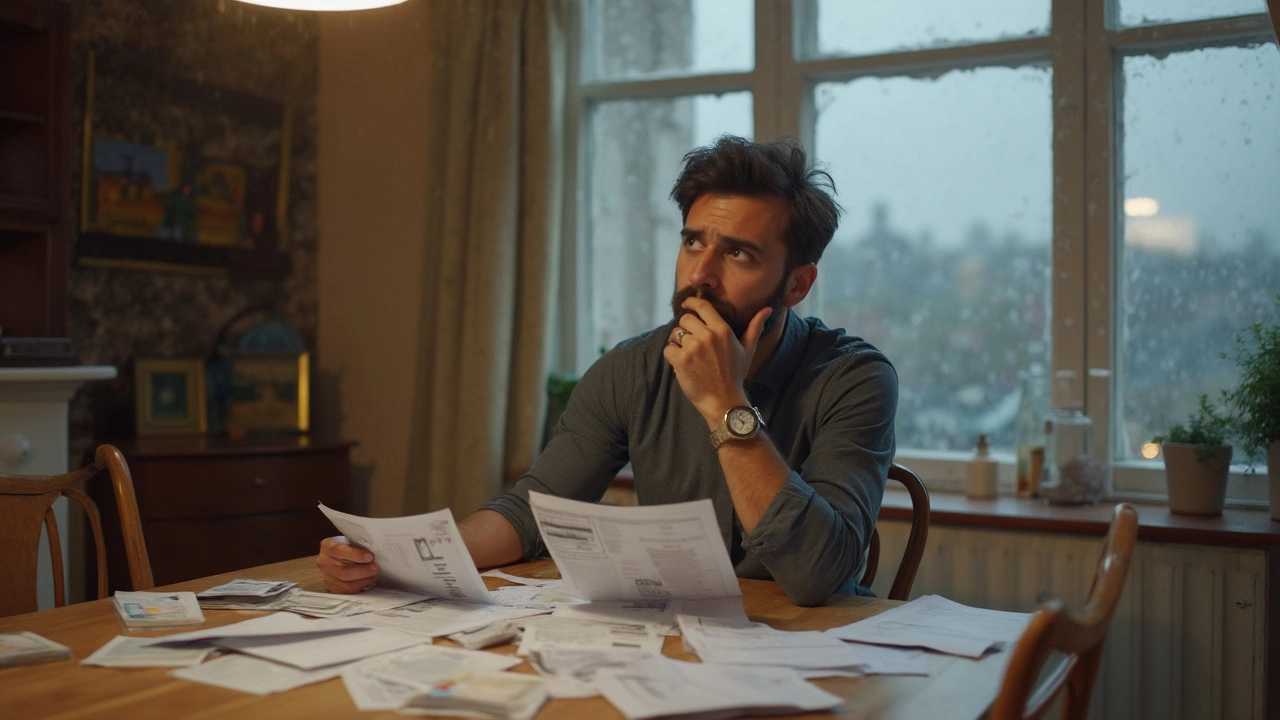If you’ve ever worried about your credit card balance, you’re not alone. But hitting $50,000 in credit card debt? That’s a whole different level. The truth is, very few people in the U.S. actually carry that much on their plastic—out of 530 million credit card accounts, people with $50k+ balances make up a tiny chunk. TransUnion’s latest report puts the average balance just under $7,000. Jumping to $50,000? That’s the top 1% of credit card debt holders, maybe even less.
So, what’s it really like carrying that much debt? For most, it’s not luxury spending on vacations or fancy gadgets. We’re talking about medical bills, unexpected job loss, or years of covering basics when life spirals. If you see stories online about huge debts, it’s often a perfect storm of bad luck and high interest. The scary part: at today’s rates, $50k can rack up $12,000+ in interest alone each year. That makes it almost impossible to pay off with minimum payments.
- How Common Is $50k in Credit Card Debt?
- Why Do People Rack Up So Much?
- Big Consequences—and a Reality Check
- Realistic Moves to Escape the Debt Spiral
How Common Is $50k in Credit Card Debt?
You hear wild stories about people drowning in debt, but how many Americans are really carrying a staggering $50,000 or more in credit card balances? Numbers from credit reporting agencies like Experian and TransUnion shed some light. The average U.S. cardholder balance is just under $7,000 as of early 2025. That's way below the $50k mark. Only a tiny percentage—think less than 1%—of Americans have balances that high on their cards.
Here’s the breakdown to put things in perspective:
| Credit Card Balance | Percent of Cardholders (2024) |
|---|---|
| Under $5,000 | ~44% |
| $5,001–$10,000 | ~28% |
| $10,001–$20,000 | ~18% |
| $20,001–$50,000 | ~9% |
| $50,000+ | ~1% |
If you compare that to the 130 million households in the U.S., you’re looking at a pretty small club for those with 50k credit card debt. In fact, Experian’s last deep-dive found high-balance borrowers were most likely to be a mix of older adults managing multiple cards, business owners hitting bumps in the road, or folks dealing with major emergencies.
For almost everyone else, balances are nowhere near that level. Most banks don’t even offer limits that high unless your credit is squeaky clean. Sometimes these giant debts belong to couples or families who’ve shared big credit lines over several years rather than one wild spender.
The bottom line? If you’re worried because your balance is creeping up, remember: $50k in credit card debt is extremely rare, but just as hard to manage as it sounds.
Why Do People Rack Up So Much?
When you hear someone has $50,000 in credit card debt, it sounds wild at first. But there are reasons people end up in this situation—and it isn’t always about shopping sprees or poor choices. Let’s break down how people actually wind up here.
First up: medical bills. Around two-thirds of bankruptcies in the U.S. can be traced back to medical expenses. If insurance won’t cover something or emergencies strike, credit cards are often the easiest way to pay right away, even though it’s a pricey solution.
Job loss comes next. According to Pew Research, nearly 50% of folks who lost jobs during the pandemic fell behind on bills. Losing income means some use credit cards for everything—groceries, gas, rent—just to get by until things turn around.
Life changes and accidents can hit hard, too. Divorce, car repairs, moving for a job, or even just a busted fridge can send monthly budgets off the rails. If savings run out, people reach for credit their credit card debt piles up quickly when it’s covering basic needs instead of extras.
It’s not always about spending too much, but also about how easy it is to only pay the minimum. Credit companies make it tempting—those minimum payments look manageable, but they barely dent the balance. Interest snowballs and, before you know it, that balance can double or even triple over the years.
- Nearly 40% of Americans say they’ve used credit cards to cover essential expenses in the past year—Source: Federal Reserve survey, 2024.
- High interest rates, averaging 21% in 2025, make it almost impossible to dig out once you pass a certain threshold.
- Credit limits keep rising for some—banks have raised average available credit by 25% since 2020, giving some people even more rope to get tangled in.
It’s a mix of bad luck, emergencies, and a financial system set up to make debt sticky. Anyone could get there faster than they think if life gets messy enough.

Big Consequences—and a Reality Check
Carrying $50,000 in debt on your credit card isn’t just some number on a statement. It hits your wallet, your mood, and even your future. The first and loudest alarm: your credit score takes a nosedive. Once credit utilization nudges over 30%, your score can drop fast, and with $50k, you’re way past that. Lenders see this as a giant red flag. Getting approved for a car loan, another card, or even a mortgage suddenly gets way harder—or the rates get brutal.
Here’s what else changes fast when you owe this much:
- 50k credit card debt isn’t manageable with minimum payments alone. If your interest rate is around 22% (pretty average right now), and you only pay the minimum, you could end up throwing away decades and tens of thousands just in interest. That’s actual money leaving your pocket every month, not just numbers on a page.
- It’s mentally exhausting. People talk about debt stress like it’s no big deal, but studies by the American Psychological Association show high debt leads to anxiety, sleepless nights, and even depression. Money troubles spill into work, relationships, and your health.
- Collection calls and legal headaches can start if you fall behind too far. Most issuers will start calling after 30 days late, and some sell your debt to collectors within months. That can tank your score even more and open you up to lawsuits.
- Forget big financial moves for a while. Banks won’t touch you for new loans or credit. In some cases, even landlords check your credit, so it can affect where you live.
It’s not all doom and gloom—but this is a real wake-up call for anyone teetering close to this debt level. If you’re here, it’s time to get blunt about cutting expenses, finding more income, and looking at real solutions before things spiral further.
Realistic Moves to Escape the Debt Spiral
If you’ve got $50,000 in credit card debt, the usual advice about cutting coffee isn’t going to fix it. Here’s the reality—people dig out of huge debt with a mix of strategy, negotiation, and sometimes tough changes. First, you have to get real about the numbers and attack the highest-interest cards first. This is called the avalanche method, and it’s a favorite of folks getting serious about big balances. If that feels totally unmanageable, there are other options that make sense at this level.
- Consider a debt management plan: Nonprofit credit counselors can work with you (for free or a small fee) to roll different cards into a single monthly payment—often at a reduced interest rate. It won’t hurt your credit as much as bankruptcy, and most major card companies participate.
- Look into a debt consolidation loan: If your score is at least fair, you might snag a loan with lower interest. It won’t magically erase debt, but rolling everything into one payment can make things feel more doable. Just watch out for fees and high rates.
- Negotiate with card companies directly: If you’re way behind, most creditors would rather get something than nothing. You can ask for temporary hardship programs, lower rates, or even settlement offers where you pay less than the full balance.
- As a last resort, bankruptcy is a tool: It can wipe out unsecured credit card balances, but it comes with a big impact on your credit. Still, about 370,000 U.S. filers each year use this option—most after other methods failed.
If you’re making moves against serious credit card debt, don’t ignore your budget. It’s boring but powerful. A 2024 FINRA study found people using written budgets paid down debt 38% faster than those winging it. You don’t have to track every penny—just get honest about what’s coming in and where the money’s going out.
Let’s get specific. Here’s a quick table showing how monthly payments stack up for a 50k credit card debt at different interest rates, assuming you want out in 5 years:
| APR | Monthly Payment | Total Interest Paid (5 years) |
|---|---|---|
| 15% | $1,190 | $21,383 |
| 20% | $1,324 | $29,423 |
| 24% | $1,433 | $36,012 |
That kind of payment is not easy for everyone, but seeing the reality can help you decide which escape route to take. The key: Don’t ignore the pile or hope it goes away. Facing the numbers head-on gives you the power to start shrinking them, little by little.

